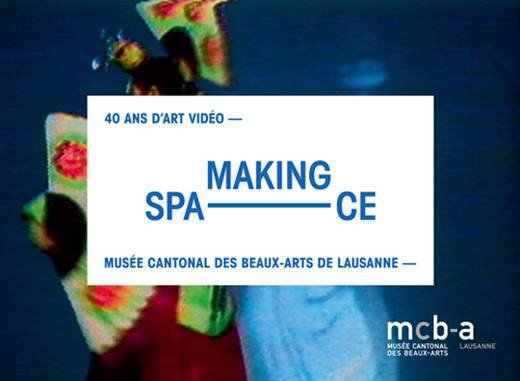Making Space. 40 Years of Video Art
dal 16/10/2013 al 4/1/2014
Segnalato da
Eija-Liisa Ahtila
Judith Albert
Francis Alys
Emmanuelle Antille
Rene Bauermeister
Dara Birnbaum
Paul Chan
Silvie et Cherif Defraoui
VALIE EXPORT
Dan Graham
Joan Jonas
Kim Sooja
Ana Mendieta
Bruce Nauman
Jean Otth
Nam June Paik
Anne-Julie Raccoursier
Pipilotti Rist
Anri Sala
Gerry Schum
Richard Serra
Salla Tykka
Bill Viola
Nicole Schweizer
16/10/2013
Making Space. 40 Years of Video Art
Musee cantonal des Beaux-Arts MCBA, Lausanne
The exhibition presents works by major artists in this genre, with all generations intermingled. It explores the way in which artists have played with the medium itself, creating scenarios where television features itself as an object and a means of broadcasting, subversively misappropriating both the medium and the message.

Curator Nicole Schweizer
With works by: Eija-Liisa Ahtila, Judith Albert, Francis Alÿs, Emmanuelle Antille, René Bauermeister, Dara Birnbaum, Paul Chan, Silvie & Chérif Defraoui, VALIE EXPORT, Dan Graham, Joan Jonas, Kim Sooja, Ana Mendieta, Bruce Nauman, Jean Otth, Nam June Paik, Anne-Julie Raccoursier, Pipilotti Rist, Anri Sala, Gerry Schum, Richard Serra, Salla Tykkä, Bill Viola.
In 1973 video celebrated its tenth birthday, and Nam June Paik made what would
become the cult tape of the history of video – Global Groove. That same year the
Musée cantonal des Beaux-Arts of Lausanne started its collection of videos by
acquiring Limite E (1973), a work by Jean Otth.
In doing so the Lausanne museum played a trailblazing role (it was only in the late
1970s that the museums of Basel, Zurich and Bern began to introduce video into
their collections), in response to the works of Swiss French-speaking pioneers of
video art. The artists René Berger, the Director of the Museum at the time, dubbed
the “musketeers of the invisible” (René Bauermeister, Gérald Minkoff, Muriel Olesen, Jean Otth, Janos Urban) were involved not only in creating video art, but also
in making it known by means of the events they organized from 1972 on, particularly in the context of the group Impact.
Since then, from experimenting with the medium to using it to record actions, from
the TV set to projection, from the frontal relationship with viewers to their involvement in the installation space, video has developed in a number of radically
different ways. Thus Making Space sets out to cover forty years of video art in
large strides, in the spaces opened up by the moving image, in a museum that
has always given it a special place, both where the collection is concerned and in
monographic exhibitions by major artists, from Bill Viola to Renée Green, by way of
Bruce Nauman, Alfredo Jaar or indeed Nalini Malani.
Making Space suggests an unusual and novel way of looking at a medium that is
most frequently associated with the recording of time and the staging of a story.
It brings together works in which the common denominator is the recording or
reconstructing of the space that can be seen, the space inhabited by the artist’s
body, and lastly the space enlivened by the presence of onlookers. Structured
non-chronologically round such themes as TV as Exprimentation Space (from
Closed Circuit to Broadcasting), Spaces for Creation (the Street, the City), Measuring Space (from Land Art to the Politics of Space), and Imaginary Space, Mental
Space, the exhibition presents works by major artists in this genre, with all generations intermingled. It explores the way in which artists have played with the medium
itself, creating scenarios where television features itself as an object and a means
of broadcasting, subversively misappropriating both the medium and the message
(Nam June Paik, Global Groove, 1973; Dara Birnbaum, Technology/Transformation: Wonder Woman, 1978-79). The exhibition also presents the way in which
the artists explore the link with viewers, by turning them into an integral part of the
work, at first by the device of closed circuit television, then, from the early 1990s
on, through installations in which the projection literally encompasses the viewer
(Emmanuelle Antille, As deep as our sleep, as fast as your heart II, 2001).
Thus Making Space takes us on a walk that leads from New York’s derelict areas
(Joan Jonas, Songdelay, 1973) to major cities throughout the world (Kim Sooja,
A Needle Woman (Performed in Tokyo, Shanghai, Delhi, New York, Mexico City,
Cairo, Lagos and London), 1999-2000), by way of Tirana (Anri Sala, Dammi i
Colori, 2003) or Finland (Salla Tykkä, Lasso, 2000), from urban space (Francis
Alÿs, Railings, 2004) to imaginary spaces (Eija-Liisa Ahtila, The House, 2002).
The exhibition has received generous loans from the MoMA, New York, the
Centre Pompidou, Paris, the Kunstmuseum in Bern, the Kunstmuseum in
Basel, the Musées d’art et d’histoire in Geneva, as well as numerous loans
from the artists and their respective galleries.
The exhibition has received support from Videocompany and Payot Lausanne.
Media contac:
Loïse Cuendet Tel. direct: +41 (0)21 3163448 loise.cuendet@vd.ch
Opening reception Thursday 17 October 2013 at 11 am
Musée cantonal des Beaux-Arts
Palais de Rumine, Place de la Riponne 6 CH - 1014 Lausanne
Opening hours:
Tuesday to Wednesday: 11 am - 6 pm
Thursday: 11 am - 8 pm
Friday to Sunday: 11 am - 5 pm
Closed on Monday
24, 26, 31 December: 11 am - 5 pm
Closed on 25 December, 1 and 2 January
Admission
Adults: CHF 10.–
Pensioners, students, apprentices: CHF 8.–
Under 16: free
1st Saturday of the month: free



